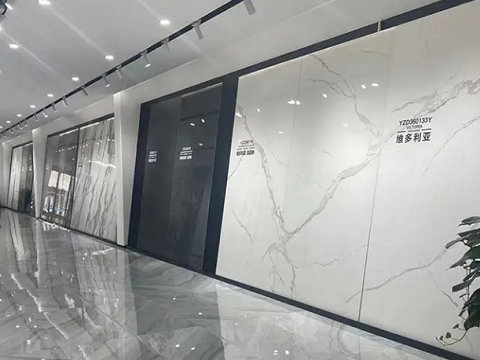Porcelain Slabs
Porcelain slabs is named as sintered stone, which means sintered stone . It is a large format new ceramic material made of natural raw materials through special processes. It is pressed by a press of more than 10,000 tons (exceeding 15,000 tons), combined with advanced production technology, and fired at a high temperature of over 1,200°C. It can withstand processing procedures such as cutting, drilling, and grinding. Through digital distribut application and other technologies, the color, texture, and material of the glaze surface are made similar to those of the body substrate , creating an appearance close to through-body consistency. Most of them feature a matte finish, restoring the texture of rock surfaces.

Architectural Marvel: Exterior Cladding
In the realm of architecture, porcelain slabs are increasingly being used as exterior cladding. Their resistance to weather elements such as rain, snow, UV rays, and extreme temperatures makes them an ideal choice for protecting the facades of buildings. Porcelain plates come in a wide range of colors, textures, and finishes, allowing architects to create visually striking exteriors that can mimic the look of natural stone, wood, or even concrete. For instance, a building clad in sleek, dark – colored porcelain boards can exude a modern and sophisticated aura, while those with earthy – toned, stone – textured porcelain panels can blend harmoniously with the surrounding environment, giving the structure a more organic and timeless appeal.
Interior Elegance: Wall Applications
The versatility of porcelain slabs also extends to interior wall applications. In bathrooms, they offer a hygienic and easy – to – clean surface. Unlike traditional tiles, porcelain panels have fewer grout lines, reducing the potential for mold and mildew growth. They can be used to cover entire walls, creating a seamless and luxurious look. Whether it’s a minimalist, spa – like bathroom with white, glossy porcelain sheets or a more rustic – inspired space with wood – look porcelain big size tiles, the material can transform the ambiance of the room. In living rooms and hallways, Ceramic slabs can serve as statement walls, adding a touch of elegance and uniqueness to the interior design.
Kitchen Essential: Countertops
One of the most common applications of porcelain slabs is in kitchen countertops. The non – porous surface of porcelain panels makes them highly resistant to stains, scratches, and heat. This means that spills from coffee, wine, or acidic foods can be easily wiped away without leaving a trace, and hot pots and pans can be placed directly on the surface without causing damage. Porcelain plates also come in a variety of patterns, from subtle veining that resembles marble to bold, abstract designs. This allows homeowners to choose a countertop that not only meets their functional needs but also complements the overall style of their kitchen, whether it’s contemporary, traditional, or eclectic.
Furniture Fashion: Tabletops
Porcelain slabs are also making a mark in the world of furniture. They can be used to create tabletops, both for dining tables and coffee tables. The large size of the slabs means that a single piece can form a spacious and continuous tabletop, eliminating the need for seams. The durability of porcelain ensures that the tabletop can withstand daily use, making it suitable for both residential and commercial settings. Additionally, the unique aesthetic of porcelain boards can make the furniture a focal point in any room.
Outdoor Oasis: Patios, Walkways, and Pool Decks
In outdoor spaces, porcelain slabs are becoming a popular choice for patios, walkways, and pool decks. Their slip – resistant properties make them safe for use around water, and their resistance to fading and discoloration ensures that they maintain their beauty over time, even when exposed to the sun. Porcelain composite slabs can be used to create different patterns and designs, adding a decorative element to the outdoor area. For example, a geometric pattern of porcelain sheets can give a modern look to a patio, while a random – layout with natural – looking ceramic slabs can create a more relaxed and rustic atmosphere.
Decorative Detail: Backsplashes
Moreover, porcelain slabs are being used in the creation of backsplashes, both in kitchens and bathrooms. They can add a pop of color or a unique texture to the space, enhancing the overall visual appeal. The ease of maintenance of porcelain backsplashes makes them a practical choice, as they can be quickly cleaned with a damp cloth.
Conclusion: The Future of Porcelain Slabs
In conclusion, porcelain slabs have carved out a niche for themselves in the design and construction industry due to their unparalleled combination of aesthetic appeal and practical functionality. From enhancing the exterior beauty of buildings to transforming the interior spaces and outdoor areas, their applications are truly diverse. As technology continues to advance, we can expect to see even more innovative uses of porcelain plates, further expanding their role in shaping the built environment.
